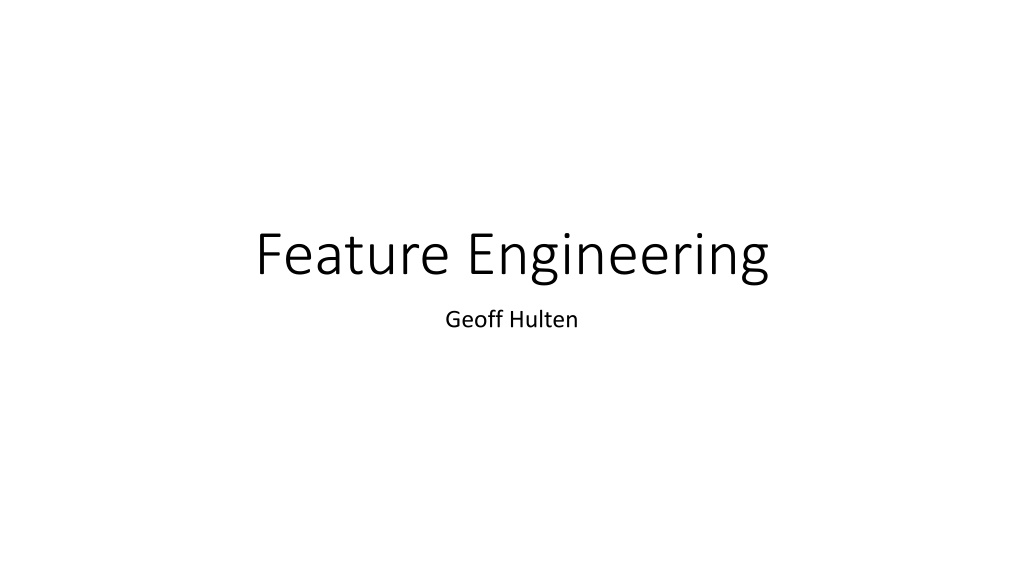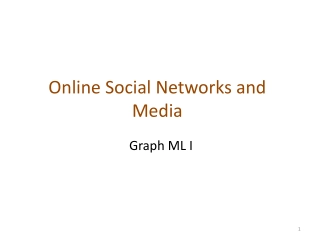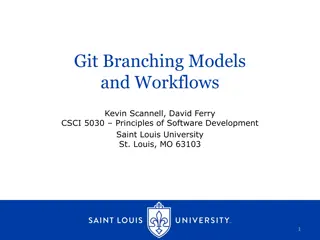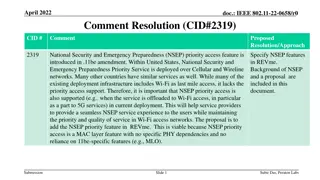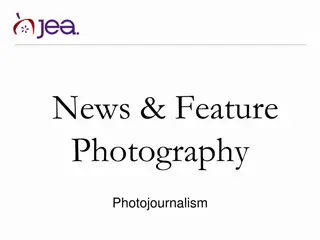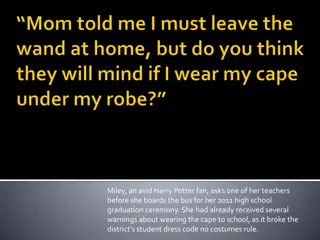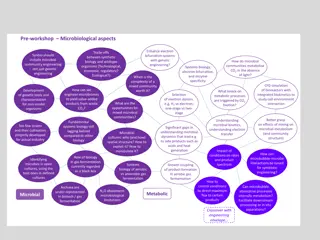Feature Engineering
Harness the power of feature engineering to optimize your data analysis processes. Discover valuable insights and enhance the performance of your predictive models through innovative techniques and strategies. Streamline your workflow and uncover hidden patterns within your datasets by mastering the art of feature engineering.
Download Presentation

Please find below an Image/Link to download the presentation.
The content on the website is provided AS IS for your information and personal use only. It may not be sold, licensed, or shared on other websites without obtaining consent from the author.If you encounter any issues during the download, it is possible that the publisher has removed the file from their server.
You are allowed to download the files provided on this website for personal or commercial use, subject to the condition that they are used lawfully. All files are the property of their respective owners.
The content on the website is provided AS IS for your information and personal use only. It may not be sold, licensed, or shared on other websites without obtaining consent from the author.
E N D
Presentation Transcript
Feature Engineering Geoff Hulten
Overview Feature engineering overview Common approaches to featurizing with text Feature selection Iterating and improving (and dealing with mistakes)
Goals of Feature Engineering Convert context -> input to learning algorithm. Expose the structure of the concept to the learning algorithm. Work well with the structure of the model the algorithm will create. Balance number of features, complexity of concept, complexity of model.
Sample from SMS Spam SMS Message (arbitrary text) -> 5 dimensional array of binary features 1 if message is longer than 40 chars, 0 otherwise 1 if message contains a digit, 0 otherwise 1 if message contains word call , 0 otherwise 1 if message contains word to , 0 otherwise 1 if message contains word your , 0 otherwise SIX chances to win CASH! From 100 to 20,000 pounds txt> CSH11 and send to 87575. Cost 150p/day, 6days, 16+ TsandCs apply Reply HL 4 info Long? HasDigit? ContainsWord(Call) ContainsWord(to) ContainsWord(your)
Basic Feature Types Categorical Features Binary Features Numeric Features CountOfWord(call) ContainsWord(call)? FirstWordPOS -> { Verb, Noun, Other } MessageLength IsLongSMSMessage? MessageLength -> { Short, Medium, Long, VeryLong } FirstNumberInMessage Contains(*#)? TokenType -> { Number, URL, Word, Phone#, Unknown } WritingGradeLevel ContainsPunctuation? GrammarAnalysis -> { Fragment, SimpleSentence, ComplexSentence }
Converting Between Feature Types numeric feature + single threshold => Binary Feature Length of text + [ 40 ] => { 0, 1 } numeric feature + set of thresholds => Categorical Feature Length of text + [ 20, 40 ] => { short or medium or long } categorical feature + one-hot encoding => Binary Features { short or medium or long } => [ 0, 0, 1] or [ 0, 1, 0] or [1, 0, 0]
Types of Features System State Settings [ high/low filter ] Roaming? Sensor readings Interaction History User s report as junk rate # previous interactions with sender # messages sent/received Content Analysis Stuff we ve been talking about Stuff we re going to talk about next Metadata Properties of phone #s referenced Properties of the sender Run other models on the content Grammar Language User Information Industry Demographics
Feature Engineering for Text Tokenizing TF-IDF Bag of Words Embeddings N-grams NLP
Tokenizing Breaking text into words Nah, I don't think he goes to usf -> [ Nah, I , don't , think , he , goes , to , usf ] Dealing with punctuation Nah, -> [ Nah, ] or [ Nah , , ] or [ Nah ] don't -> [ don't ] or [ don , ' , t ] or [ don , t ] or [ do , n't ] Normalizing Nah, -> [ Nah, ] or [ nah, ] 1452 -> [ 1452 ] or [ <number> ]
Bag of Words Add one feature per word (token) that appears: In the training set. In some pre-selected dictionary. [ feature selection, which we ll talk about soon ] Message 1: Nah I don't think he goes to usf Message 2: Text FA to 87121 to receive entry Nah I don't think he goes to usf Text FA 87121 receive entry Message 2: 0 0 0 0 0 0 1 0 1 1 1 1 1 Use when you have a lot of data, can use many features
N-Grams: Tokens Instead of using single tokens as features, use series of N tokens down the bank vs from the bank Message 1: Nah I don't think he goes to usf Message 2: Text FA to 87121 to receive entry Nah I I don t don t think think he he goes goes to to usf Text FA FA to 87121 to To receive receive entry Message 2: 0 0 0 0 0 0 0 1 1 1 1 1 Use when you have a LOT of data, can use MANY features
N-Grams: Characters Instead of using series of tokens, use series of characters Message 1: Nah I don't think he goes to usf Message 2: Text FA to 87121 to receive entry Na ah h <space> <space> I I <space> <space> d do <space> e en nt tr ry Message 2: 0 0 0 0 0 0 0 1 1 1 1 1 Helps with out of dictionary words & spelling errors Fixed number of features for given N (but can be very large)
TF-IDF Term Frequency Inverse Document Frequency Instead of using binary: ContainsWord(<term>) Use numeric importance score TF-IDF: TermFrequency(<term>, <document>) = % of the words in <document> that are <term> InverseDocumentFrequency(<term>, <documents>) = log ( # documents / # documents that contain <term> ) Words that occur in many documents have low score (??)
Embeddings -- Word2Vec and FastText Word -> Coordinate in N dimension Regions of space contain similar concepts One Option: Average vector across words Commonly used with neural networks Replaces words with their meanings sparse -> dense representation
NLP Parts of speech Structure of sentences Quality of writing Language detection
Feature Selection Which features to use? How many features to use? Approaches: Frequency Mutual Information Accuracy
Feature Selection: Frequency Take top N most common features in the training set Feature Count to 1745 you 1526 I 1369 a 1337 the 1007 and 758 in 400
Feature Selection: Mutual Information Take N that contain most information about target on the training set ?(?,?) ? ? ?(?)) ?? ?,? = ? ?,? ???( ? ? ? ? x=0 x=1 y=0 5 0 y=1 0 5 x=0 x=1 ??? + ? ? + ? y=0 5 5 ? = y=1 5 5
Feature Selection: Mutual Information Take N that contain most information about target on the training set ?(?,?) ? ? ?(?)) ?? ?,? = ? ?,? ???( ? ? ? ? Feature Mutual Information Call 0.128 to 0.090 or 0.055 FREE 0.043 ??? + ? ? + ? ? = claim 0.021
Feature Selection: Accuracy (wrapper) Take N that improve accuracy most on hold out data Greedy search, adding or removing From baseline, try adding (removing) each candidate Build a model Evaluate on hold out data Add (remove) the best Repeat till you get to N Remove Accuracy <None> 88.2% claim 82.1% FREE 86.5% or 87.8% to 89.8%
Important note about feature selection Do not use validation (or test) data when doing feature selection Use train data only to select features Then apply the selected features to the validation (or test) data
Simple Feature Engineering Pattern for f in featureSelectionMethodsToTry: (trainX, trainY, fParameters) = FeaturizeTraining(rawTrainX, rawTrainY, f) (validationX, validationY) = FeaturizeValidation(rawValidationX, rawValidationY, f, fParameters) for p in parametersToTry: model.fit(trainX, trainY, p) accuracies[p, f] = evaluate(validationY, model.predict(validationX)) (bestPFound, bestFFound) = bestSettingFound(accuracies) (finalTrainX, finalTrainY, fParameters) = FeaturizeTraining(rawTrainX + rawValidationX, rawTrainY + rawValidationY, bestFFound) (testX, testY) = FeaturizeValidation(rawTextX, rawTestY, bestFFound, fParameters) finalModel.fit(finalTrainX, finalTrainY, bestPFound) estimateOfGeneralizationPerformance = evaluate(testY, model.predict(testX))
Understanding Mistakes Noise in the data Encodings Bugs Missing values Corruption Noise in the labels ham As per your request 'Melle Melle (Oru Minnaminunginte Nurungu Vettam)' has been set as your callertune for all Callers. Press *9 to copy your friends Callertune spam 08714712388 between 10am-7pm Cost 10p Model being wrong Reason?
Exploring Mistakes Examine N random false positive and N random false negatives Reason Count Label Noise 2 Slang 5 Non-English 5 Examine N worst false positives and N worst false negatives Model predicts very near 1, but true answer is 0 Model predicts very near 0, but true answer is 1
Approach to Feature Engineering Start with standard for your domain; 1 parameter per ~10 samples Try all the important variations on hold out data Tokenizing Bag of words N-grams Use some form of feature selection to find the best, evaluate Look at your mistakes Use your intuition about your domain and invent new features Iterate When you want to know how well you did, evaluate on test data
Feature Engineering in Other Domains Computer Vision: Gradients Histograms Convolutions Internet: IP Parts Domains Relationships Reputation Time Series: Window aggregated statistics Frequency domain transformations Neural Networks: A whole bunch of other things we ll talk about later
